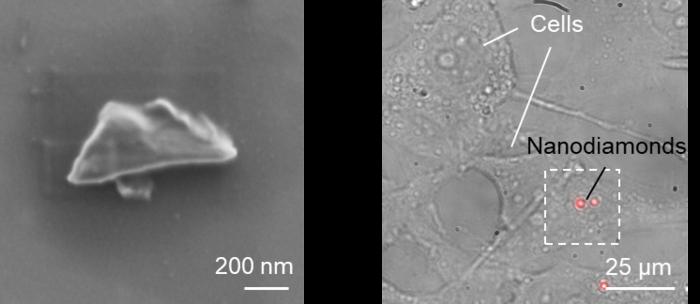In a groundbreaking development within the realm of nanotechnology, researchers at Okayama University in Japan have successfully engineered a new class of nanodiamonds (NDs) that possess exceptional spin properties and superior fluorescence performance. This advancement holds significant promise for a range of applications, particularly in the burgeoning field of quantum sensing and bioimaging. By harnessing the unique characteristics of nitrogen-vacancy (NV) centers in diamond structures, these researchers have taken a substantial step forward in the quest for enhanced, biocompatible sensing technologies that can operate at the quantum level.
Nanodiamonds are an innovative form of carbon allotropes that offer remarkable versatility due to their unique optical and electronic properties. The NV centers, created by substituting nitrogen atoms for carbon near a vacancy in the diamond lattice, exhibit exceptional stability and sensitivity to external stimuli. This allows them to serve as effective quantum sensors, capable of detecting variations in magnetic fields, electric fields, and environmental temperatures. By measuring changes in the spin states of these NV centers, researchers can glean crucial information about the surrounding biological environment, paving the way for transformative advancements in medical diagnostics and treatment.
The primary goal of the research led by Professor Masazumi Fujiwara was to optimize the properties of nanodiamonds to surpass the limitations associated with current bioimaging techniques. Traditional NDs often suffer from reduced sensitivity due to high concentrations of spin impurities, which disrupt the delicate spin states essential for accurate measurements. The new NDs developed by the team exhibit drastically improved spin quality, with significantly longer spin relaxation times compared to their commercial counterparts, enabling a level of precision that was previously unattainable.
Achieving these enhanced properties required meticulous attention to the synthesis process. The researchers utilized single-crystal diamonds, meticulously enriched with isotopically pure ^12C carbon atoms to ensure minimal impurities. This was followed by the careful introduction of a controlled amount of nitrogen during the growth process to create NV centers without compromising the overall structural integrity of the diamonds. Consequently, the resulting nanodiamonds were characterized by a remarkably low impurity concentration, enabling them to exhibit improved fluorescence and spin properties.
In practical terms, the new nanodiamonds demonstrated a photon count rate impressive enough for effective bioimaging applications, achieving a remarkable 1500 kHz. This level of brightness is a testament to their potential for in vivo imaging, allowing researchers to visualize cellular environments with unprecedented clarity. In addition, these new NDs exhibit sensitivity to even minute temperature variations, an essential factor for tracking dynamic biological processes in real time.
The researchers carried out extensive doping experiments, manipulating the nitrogen concentration to optimize the density of NV centers within the nanodiamonds. The outcomes of these experiments revealed NDs that not only retained high spin coherence but also required significantly lower microwave power to achieve desired measurement sensitivity. These findings elucidate a critical advancement toward enhancing the viability of quantum sensing in delicate biological contexts, reducing the risk of thermal damage to cells during imaging procedures.
Furthermore, the nanodiamonds were subjected to experiments within HeLa cells, widely used in biological research. The results showed how comfortably these nanodiamonds integrated into the biological systems, with their ability to generate clear and reliable spectra even in the presence of Brownian motion ensuring their observational accuracy. Such capacities highlight the duality of nanodiamonds as both imaging agents and sensors, propelling further inquiry into their potential applications in monitoring cellular health and biochemical activities.
As biological systems are inherently complex, the team meticulously evaluated the nanodiamonds’ performance at varying temperatures, revealing not just improved facilities for bioimaging, but also a profound capacity for temperature sensitivity assessment. This discovery has far-reaching implications, as monitoring temperature fluctuations is critically relevant in numerous biological processes, including cellular metabolism and pathophysiology.
The implications of such advancements in nanodiamond technology extend far beyond biological applications. As the demand for real-time, non-invasive sensing solutions escalates across diverse fields, these quantum-grade NDs could revolutionize numerous sectors by facilitating early disease detection and enabling advanced monitoring of vital systems. Their versatility positions them as crucial components in the future development of enhanced energy management systems, environmental monitoring solutions, and sophisticated electronic devices, offering sustainable solutions to pressing challenges.
Prof. Fujiwara modestly anticipates the transformative potential of this work, suggesting that the integration of these advanced nanodiamonds into practical applications may lead to advancements in healthcare and environmental management that were previously thought impossible. As research in quantum sensing and nanotechnology continues to evolve, the spotlight now shines brightly on the role of these outstanding nanodiamonds in shaping the future of scientific innovation.
The multidisciplinary nature of this research illustrates the convergence of physics, chemistry, and biological sciences, underscoring the collaborative efforts needed to push the boundaries of current technological capabilities. This study not only exemplifies the impact of nanotechnology on contemporary scientific practices but also serves as a clarion call for continued investment and interest in quantum materials and their applications.
In conclusion, the advent of quantum-grade fluorescent nanodiamonds marks a pivotal moment in nanotechnology, sparking new avenues of research and potential breakthroughs. The pursuit of understanding the quantum mechanical behavior of such materials continues to draw interest from researchers worldwide, illuminating new pathways for scientific inquiry and promising advancements that could enhance quality of life while addressing complex global challenges.
Subject of Research: Nanodiamonds for quantum sensing and bioimaging
Article Title: Bright quantum-grade fluorescent nanodiamonds
News Publication Date: 16-Dec-2024
Web References: ACS Nano
References: 10.1021/acsnano.4c03424
Image Credits: Masazumi Fujiwara from Okayama University
Keywords:
Quantum sensing, nanodiamonds, nitrogen-vacancy centers, bioimaging, fluorescence, cell monitoring, spin properties, thermal sensitivity, nanotechnology, medical diagnostics, environmental monitoring, sustainable solutions.




